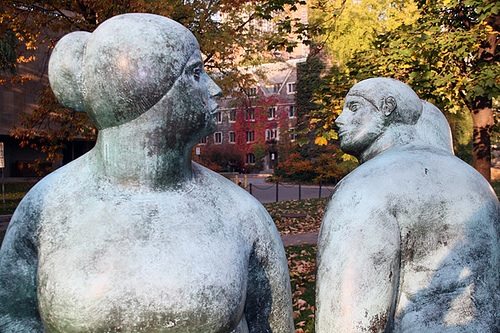
What’s a university to do, asked Tom George, the chancellor of the University of Missouri-St. Louis, regarding how an anchor institution like UMSL might best address the dynamic in St. Louis County in the wake of Michael Brown’s shooting and the subsequent protests concerning policing, racial discrimination, and societal inequalities.
Beyond issuing statements of concern and offering spaces for dialogue and understanding, major community institutions such as universities and hospitals are sometimes flummoxed with determining how they might respond to social dynamics in their communities and regions—not on the spur of the moment, but for the long term, with concrete actions that capitalize on their “anchor institution” roles. The Center for American Progress issued a report today, Eds, Meds, and the Feds: How the Federal Government Can Foster the Role of Anchor Institutions in Community Revitalization, that never once mentions Ferguson or identifies race or racism as a specific issue but remains timely and pertinent for what is happening today.
In Eds, Meds, and the Feds, author Tracey Ross, a Senior Policy Analyst at the Center for American Progress, covers some of the landscape of federal government initiatives that take advantage of the presence and capacity of universities and hospitals in the revitalization of communities. Among the current federal efforts she lists is the Obama administration’s Promise Neighborhoods program (administered by the Department of Education), modeled on the Harlem Children’s Zone, but through the competitive grants process, made available to applicants that included institutions of higher education. As an example, Ross highlights Texas Tech’s role as an anchor institution behind the East Lubbock Promise Neighborhood, a project being implemented in conjunction with the Lubbock Independent School District and a couple of dozen other community organizations.
She also takes note of the somewhat lesser known Choice Neighborhoods program of the U.S. Department of Housing and Urban Development. In the HUD criteria for selecting potential Choice Neighborhoods projects that would support comprehensive community revitalization, one factor is “anchor institution engagement,” to show how local eds and meds provide opportunities for and contribute to neighborhood strategies. Her example here is the role of Seattle University as the lead education partner in that city’s Choice Neighborhoods program, working with the Seattle Housing Authority, the Seattle Public Schools, and the YMCA in a comprehensive strategy linking housing and education.
Quite smartly, Ross also notes the possibilities that the Affordable Care Act could undertake if the nation takes the community health benefit and community health needs assessment requirements of the legislation seriously. “The hope,” she writes, “is that with more insured patients, the hospital can devote more resources toward addressing some of the social determinants of health, such as living in highly polluted neighborhoods.”
One of the roles that Ross outlines for anchor institutions is real estate development, helping distressed communities with residential and mixed-use development. She notes, as an example of a problem, the community resistance regarding Columbia University’s “expansion into Harlem,” which she contrasts with a more positive example of Johns Hopkins Hospital and Johns Hopkins University School of Medicine in East Baltimore, with Hopkins playing a “central role” in a comprehensive redevelopment plan that included the creation of a new public elementary school and an early childhood center. This view of Johns Hopkins in East Baltimore is slightly myopic and ahistorical, given that the university’s past plans were more geared toward urban removal of much of the surrounding neighborhood and were compelled to be more attentive to neighborhood concerns because of the organizing of community-based organizations and political leaders.
Similarly highly touted anchor institution redevelopment strategies, such as the University of Pennsylvania’s in West Philadelphia, cleared and displaced blocks upon blocks of residents. In the competitive world of higher education, top flight universities sometimes found their marketing hampered by students’ and parents’ fears of dangerous surrounding neighborhoods and, in line with the approaches taken by many city governments, adopted strategies more geared to removal than renewal when it came to the interests of existing residents. In many cases of more successful anchor institution development strategies, the engagement of the institutions with community residents in legitimate, more authentic partnerships was essential to ensure that more than the anchors’ concerns were being tended to. Examples that come to mind include Trinity College’s engagement in Hartford’s Southside Institutions Neighborhood Alliance (SINA), which led to affordable housing development in the Frog Hollow neighborhood and the creation of the “Learning Corridor.” Similarly, despite a long history of town/gown tensions, Yale University has partnered with community organizations, particularly in the Dwight neighborhood of New Haven, for productive ventures.
Ross also lists other roles for eds and meds—as employers that can target local residents for job training and placement; workforce developers, as in the case of the Partners HealthCare system in Boston, working on helping young people with preparing for health care careers; purchasers, like Temple University in Philadelphia and the Greater University Circle Initiative institutions in Cleveland, emphasizing buying locally; and as providers of core goods and services.
In its section on building community infrastructure, the CAP report focuses on educational and medical institutions, but communities have a wider array of institutions to draw on for anchor roles. Ross describes the Woodward Corridor Initiative, with its focus on the Midtown area adjacent to Detroit’s downtown. Emphasizing the Live Midtown program, a partnership of the Henry Ford Health System, Wayne State University, and the Detroit Medical Center, Ross describes the incentives offered by these anchor institutions to attract their employees to live in the area, creating the neighborhood population density and urban vitality that so much of Detroit so desperately needs.
Midtown’s revitalization, however, involves many more anchor institutions than just the eds and meds. Key players also include the Detroit Public Library, the Detroit Institute of Arts, Orchestra Hall, and the Charles H. Wright Museum, the nation’s largest black museum. The Midtown strategy, however, is not without controversy. Longtime residents in the area feel at times that the revitalization of Midtown isn’t as much for them as it is for newcomers and outsiders. Moreover, in the case of the Detroit Institute of Arts, the museum has garnered over $370 million in philanthropic and corporate commitments to keep it alive and insulated from the city’s bankruptcy, moneys that some might imagine could have and should have been dedicated to neighborhood revitalization. Sometimes anchor institutions are contributors, but in other circumstances, they can turn into takers.
Oddly, there isn’t a strong element in the report on the role of community-based organizations in working with these anchor institutions and sometimes, by necessity, holding their feet to the fire. Some years ago, Richard Schramm and the late Nancy Nye generated a very useful handbook on higher education partnerships with community-based organizations, with attention to the role of the eds in working with community development corporations, building CDC capacity, and even to a limited extent on helping create CDCs. The danger CDCs face in such instances is being seen as captured by or functioning as arms of these institutions, doing their bidding rather than the community’s, but Schramm and Nye recognized that building community infrastructure means building and strengthening the civic sector—and more diversely, as Yale has demonstrated with the Dwight neighborhood, than the institutions in Detroit have with Midtown.
It may be that Ross’s recommendations for the federal government are modest because the federal government’s horizons, due to fiscal limitations and political gridlock, are modest as well. She calls for HUD to rebuild the Office of University Partnerships, which she says could “help communities develop a way of measuring anchor impact,” suggesting the creation and use of “dashboard indicators that demonstrate community impact and can be reported to Congress.” In a way, that feels a bit like putting the cart before the horse, as though the issue were to demonstrate to legislators how much eds and meds are doing rather than pushing these institutions to use their resources to do much more, especially when the examples in the report, such as Drexel University in Philadelphia and Texas Tech in Lubbock, may be more the exception than the rule.
Sign up for our free newsletters
Subscribe to NPQ's newsletters to have our top stories delivered directly to your inbox.
By signing up, you agree to our privacy policy and terms of use, and to receive messages from NPQ and our partners.
In reality, many universities and hospitals are relatively wealthy, well endowed, and charging hefty rates for delivering their educational and health products, but not playing the kind of anchor development roles that they could or should. Ross’s report doesn’t address a fundamental problem of eds and meds, that they are wealthy institutions often providing excellent service and support to the wealthy and not so much to those of middle or moderate income or the poor. It is difficult to laud these institutions for their positive anchor development roles in communities and turn a blind eye to so much else they might be doing that is less than socially productive and positive.
For example, the Senate Finance Committee under Republicans and Democrats has taken aim at universities with massive tax-exempt endowments who pay their executives huge salaries while they raise tuitions and watch students sink into long-term debt. Senator Charles Grassley took special aim at the $685,000 severance payment that New York University gave to Jack Lew as Lew became Secretary of the Treasury. In previous years, Grassley has excoriated universities for building multi-billion tax-exempt endowments that he described as “hoarding assets at taxpayer expense.” If the federal government were to encourage in a significant way these institutions to invest their endowments in community revitalization projects and in other community institutions, that would turn at least a part of these assets toward community purposes, much like the University of Cincinnati’s dedicating a portion of its endowment to community development investments and Yale’s use of its assets, though not as aggressively as Cincinnati’s, for real estate improvement in the Dwight, Dixwell, and Hill neighborhoods.
The universities in Ross’s report are often quite wealthy, with endowments valued as of the middle of 2013 as much as Columbia’s $8.2 billion, Penn’s $7.7 billion, almost $3 billion controlled by Johns Hopkins University, not to mention the more than $32.3 billion in Harvard’s account and $20.8 billion controlled by Yale. While Ross suggests that these institutions could engage in local purchasing programs, even among smaller universities, investing a portion of their assets in their communities, especially in support of community projects, could be a major boon for community-based nonprofits strapped for capital—a strategy of investment, not just procurement.
In many communities, particularly in the Northeast and Midwest, the relationship between local governments and tax-exempt eds and meds is thin on the partnership dimension as municipalities look to deep pocketed institutions for all-but-mandatory payments in lieu of taxes. Typically, as these institutions try to minimize the potential tax-like hit they might absorb, they cite the kinds of benefits—employment, services, local procurement—that Ross describes as the upside of their anchor institution roles.
Increasingly, for hospitals, localities have found arguments about their charitable intent and purposes less and less persuasive. Unless and until the increasingly confusing patchwork of local government treatment of tax-exempt universities and hospitals is resolved, eds and meds are going to have to offer anchor partnership roles that clearly exceed what municipal governments think these institutions ought to be required to do as a matter of course. The University of Pittsburgh Medical Center’s contributions to the Pittsburgh Promise scholarship program is an example of one of the meds designing a community role that, whatever its merits, is perceived as justifying its insulation from “voluntary” property tax exactions.
Ross recommends that universities be encouraged to develop partnerships with small business and to provide mentoring services, particularly through the federal government, encouraging partnerships and mentoring in the context of federal grant programs. This is unobjectionable to be sure, but it doesn’t capture what universities might really do to target their business development programs to address specific needs and gaps. For example, at Syracuse University, the widely admired Institute for Veterans and Military Families has taken advantage of the university’s resources to offer an “entrepreneurship boot camp for veterans with disabilities” and entrepreneurship training for military families—and beyond offering these services through Syracuse, it has expanded the model to offer veterans’ entrepreneurship programs at other schools, including Texas A&M, UCLA, Purdue, the University of Connecticut, Louisiana State, Florida State, and Cornell. Utilizing university resources as anchors to target specific needs is much better than just generically suggesting partnerships and mentorships with small businesses.
The most significant and distinctive of Ross’s recommendations for federal action is to get the feds to use the Affordable Care Act to push nonprofit hospitals to perform the kinds of roles they ought to in building community health though building community:
“The new requirements in the ACA go beyond improving health to include greater accountability for hospitals, more effective use of resources, and building community capacity and engagement in addressing health issues. Hospitals should use these new requirements as an opportunity to explore the full range of social determinants of health and what their communities’ needs truly are. Federal leaders should direct hospitals to work with local leaders, particularly place-based grantees, to collaborate around the CHNA to define the scope of the community, identify community priorities, and determine how community benefit resources should be spent.”
This is a significant potential federal action, given the existence of 2,900 nonprofit hospitals that could be doing much to benefit the communities they serve beyond the services they deliver from within the hospital walls. Congress—again, the Senate Finance Committee—has raked the nonprofit hospital community across the coals, in many cases deservedly, for hospitals’ less than adequate service to poor people through confusing and inadequate charity care services. Now, with the availability of health insurance and in many states expanded Medicaid coverage, nonprofit hospitals do not face the financial burden of uncompensated charity care. To think of these hospitals as anchor institutions dedicated to community health would be a federal pivot to turn the ACA-required community health needs assessments into tools for community development as opposed to just another regulatory hurdle.
Conceiving of hospitals as anchor institutions dedicated to community health (and colleges and universities dedicated to community education) could be the change in federal policy that might be the next step in eds and meds anchor development approaches. Our review of recent reporting on community health needs assessments suggests that most give community needs relatively superficial attention in the form of background data on health indicators and next to no analysis in terms of strategies for addressing and improving community health. The muscle behind the content of the community health needs assessments may be a little thin as the federal government focuses on the ACA elements mostly on getting people insurance coverage. The purpose of the ACA is more than insurance, extending to improving access to and the delivery of healthcare services. Making the hospital anchor development role a strong component of CHNAs would be a major achievement.
Overall, Ross’s report for the Center for American Progress is a useful reminder of the potential roles of anchor institutions—universities and hospitals—in building and strengthening community. It is a little over reliant on the innate role of eds and meds as “economic engines” that can be boosted and leveraged, even with additional federal attention, against eds and meds policies that are sometimes less societally productive, and doesn’t pay sufficient attention to the roles of schools and hospitals as tax-exempt institutions sitting on billions, actually trillions in tax-exempt dollars. It addresses what these institutions do in terms of employment and workforce development, but turns pretty much a blind eye to the practice of many to provide minimal wages to lower level staff and to oppose basic union organizing on the part of janitorial and other service staff, even, to the level of opposing (or at least not supporting) living wage campaigns for the dining hall workers who often get employed and managed by third-party entities on behalf of the universities.
Eds and meds can play useful roles in building and strengthening community. The federal government can do more to make them productive and useful community partners by using federal regulatory requirements such as the CHNAs for nonprofit hospitals and by incentives in federal grant and contract awards. However, the eds and meds themselves have to conceptualize themselves as community institutions with the totality of their resources—including the investment of their tax-exempt assets and better treatment of their employees and, as appropriate, patients or students.













